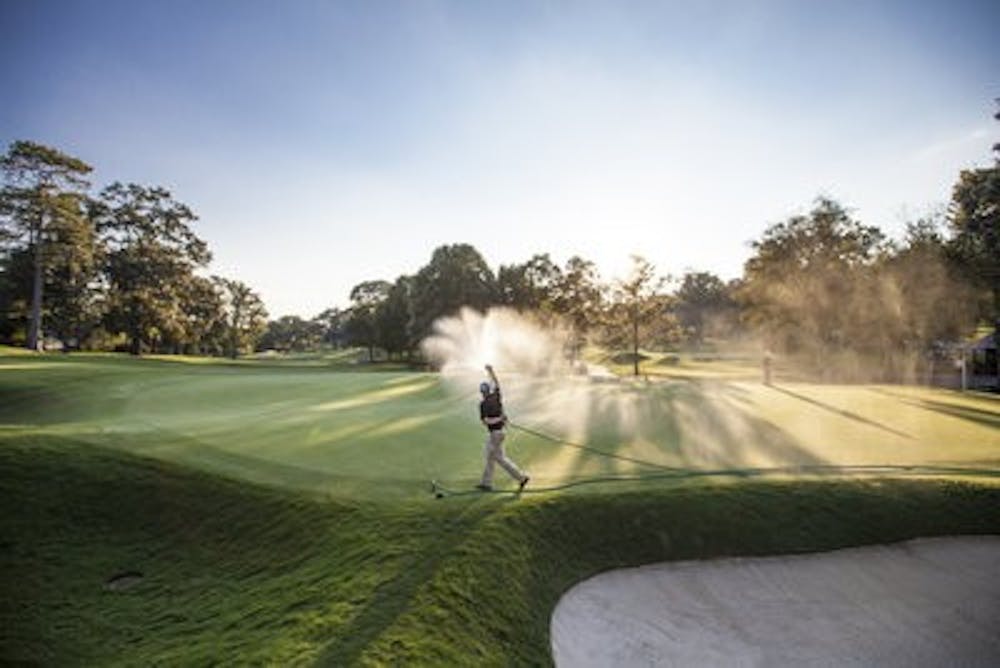Edzard Van Santen, professor in the crop soil and environmental science department, has dedicated more than a decade to the growth of a new creeping bentgrass, a grass that has long been used for putting golf green surfaces.
According to Van Santen, the new grass, named AU Victory, is a cool-season species with origins in 1999, when putting greens in the southeastern region of the United States suffered in the prolonged heat and humidity of summer, causing the grass to become too thin and resulting in poor golf greens.
Van Santen said he was first called to the Montgomery Country Club where he found only five or six good patches of grass on a 2,000-square-foot green.
"These plants had a characteristic that made them, at least to that point, survive the draught," Van Santen said. "Ultimately, if they had gone on they would have died, because a plant needs water to survive. So I picked up those survivors, took out the core and put them in a bag, transported them to the greenhouse here in Auburn and then took them to the Tennessee Valley, where we have another research center."
After the two-year waiting period passed, Van Santen said he was ready to initiate a breeding program, which involved working with a collaborator in Oregon, Virginia Lehman, who owned a private breeding company.
According to Van Santen, Lehman planted the plugs in a field and continually looked for turf quality, which is normally rated on a one to nine scale, six being an acceptable turf quality.
"What you want is leaves and not many stems," Van Santen said. "With the quality, we were looking for the fineness of leaf and uniformity. Uniformity is important because you want this average characteristic and each seed from the same mother has potentially a different father, and so there are slight differences, but on the average you want the stuff to look similar to each other."
After years of sending plants to and from Oregon and comparing their turf grass to other commercial cultivars, Van Santen and Lehman put populations of grass together, which they said they believed could be a thriving type of bentgrass, ultimately finding one population that stood above the rest.
"We eliminated a number of populations and then we allowed the remaining plants to flower together," Van Santen said. "We came up with two populations of bentgrass, and we had them here in our turf grass research unit. We put them under draught stress to see how they compared to commercial cultivars if you don't irrigate as much, and these did really well."
Bent Brook Golf Club in Birmingham was one of the first golf courses to plant its greens with the AU Victory Bentgras
Mickey Smith, director of golf at Bent Brook Golf Club, said he expects the greens on his Graveyard nine to be playable by December at the latest.

The Country Club of Birmingham assisted Van Santen early in his research, allowing him to plant AU Victory Bentgrass on the golf course years ago.
Today, Lee McLemore, director of golf course operations, said there are still a few bentgrass plots left thriving through heat and disease, a huge advantage over a number of other bentgrasses.
"This bentgrass has great draught tolerance, as well as disease tolerance," McLemore said. "Edzard gave it tough love in a survival-of-the-fittest setting and came away with a grass which could withstand heat and draught that would devastate other putting surfaces."
McLemore and Van Santen said they view draught and disease tolerance as an advantage.
McLemore said he believes the biggest advantage of the grass is that it was developed in the state of Alabama.
"They are born and bred here in Alabama, and that's big," McLemore said. "Bentgrasses are not supposed to be very well adapted to this region, but this bentgrass had adapted well. It's really the ultimate putting surface."
Do you like this story? The Plainsman doesn't accept money from tuition or student fees, and we don't charge a subscription fee. But you can donate to support The Plainsman.





